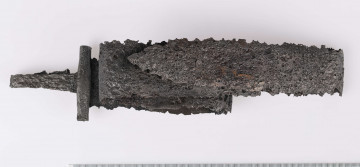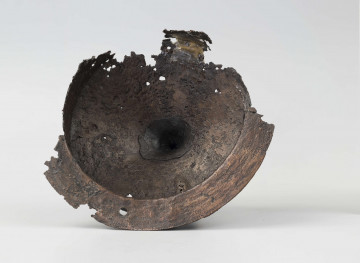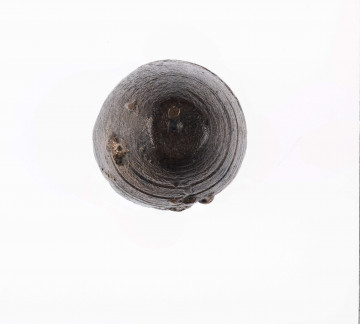
Sword
National Museum in Lublin
Part of the collection: Archaeological monuments of the Lublin region
An iron sword with a copper inlay, depicting Mars and Victoria, is part of the furnishings of a mortuary burial probably placed in an ashtray, discovered at a multicultural archaeological site.
The discovery of the grave was made in 1959 by accident, during agricultural works. The relics found in 1960 were delivered to the Regional Conservator of Monuments in Lublin, and then to the Lublin Museum.
The grave was furnished with an umbo (top of a shield) with a high blunt spike, two iron spurs, two iron javelin tips ritually bent and broken, a ferrule (probably a javelin spar fitting), and a bent javelin tip with silver inlay on the leaf and sleeve in the form of symbolic signs and lines. The inlaid sword and the spearhead are the most interesting elements of the tomb complex.
The sword is double-edged, with a straight head equipped with four scabbards, a symmetrical handle and a tapering shaft ended with a profiled plate. The head at the base is decorated with a copper inlay - a figural representation of Mars and Victoria. To make the details of the drawing more visible the inlay is supplemented with scoring and engraved lines. The sword was ritually bent, now it consists of four parts.
The inlay technique is one of the most effective decorative techniques. Most swords with this type of decoration can be counted as imports from the Roman Empire. Their manufacture required a highly developed decorative technique. It consists in pasting a thin sheet or a copper or bronze wire into engraved slots, which in combination with the iron from which the sword is forged, gives a clear, contrasting image.
This type of sword was used by heavily armed Roman cavalry. The finding of such an element of weaponry in the grave of a warrior of the Przeworsk culture, dated to the beginning of the 3rd century AD, testifies to the contact with the Roman army of population groups living far from the borders of the Empire. It is possible that this unique weapon belonged to a warrior belonging to the elite of the Przeworsk culture, who inhabited the Lublin region in the first centuries AD.
Author / creator
Dimensions
cały obiekt: height: 87,5 cm, width: 6,2 cm
Object type
weapon
Technique
forging
Material
iron, copper
Creation time / dating
Creation / finding place
Owner
The National Museum in Lublin
Identification number
Location / status

National Museum in Lublin

201 — 210
National Museum in Lublin

201 — 210
National Museum in Lublin
DISCOVER this TOPIC
National Museum in Lublin
DISCOVER this PATH
Educational path